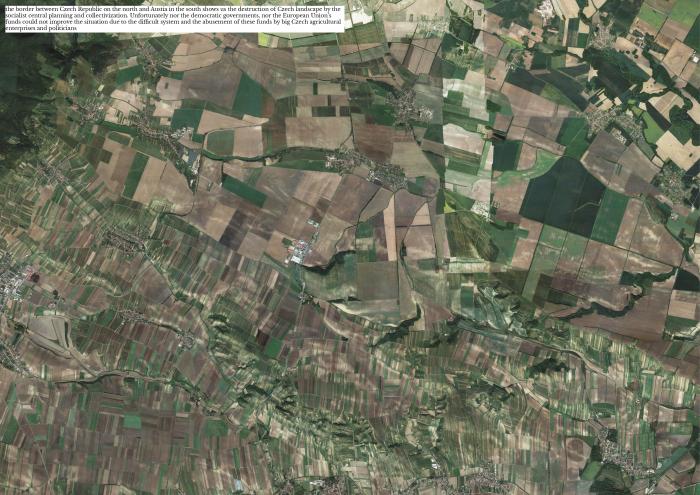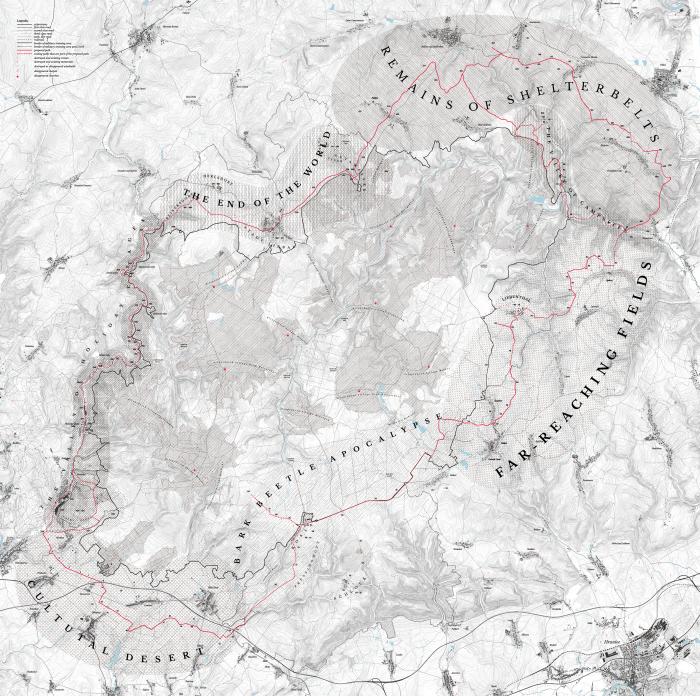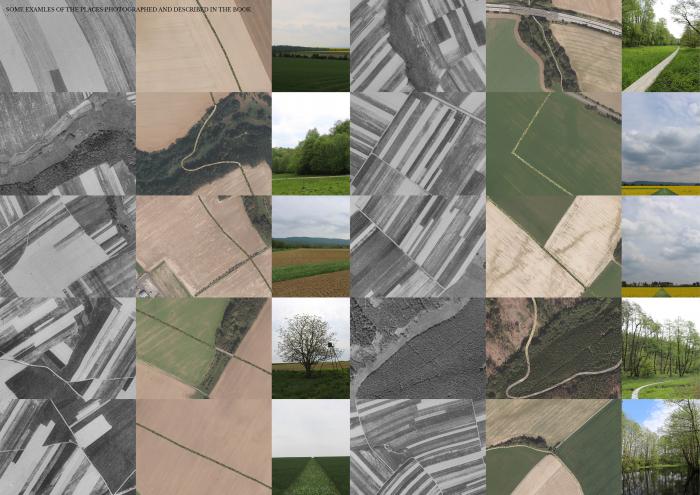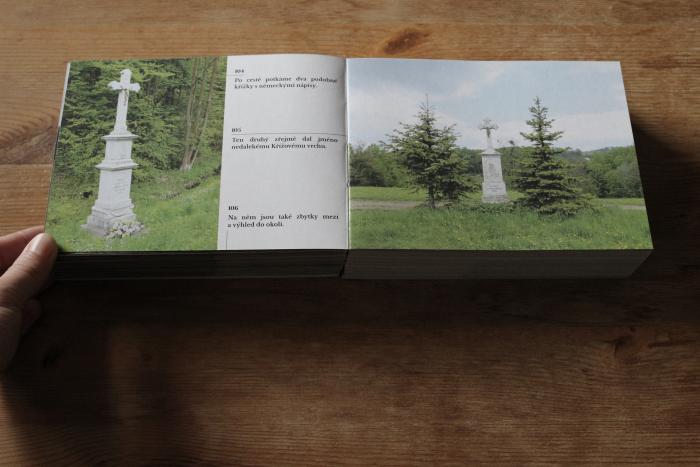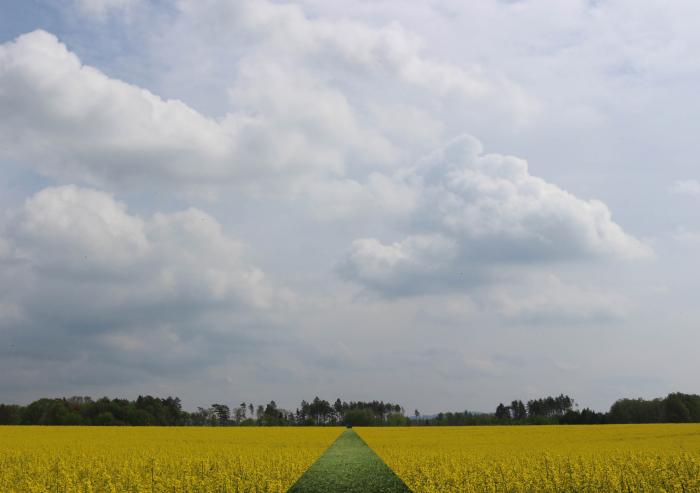Libavsko is a part of the hills of northern Moravia. The landscape of fields and windmills, nurtured for centuries, has gone through a complex history that resulted in the post-war displacement of the vast majority of the locals. They were replaced by people for whom the landscape never really became home. The decaying villages and fields reflect the fate of the Sudetenland, whose problems still affect our society. We can learn a lot about ourselves on a journey through the Atlas of Emptiness.
The characteristics of rural areas vary from region to region, but few regions are as specific as Libavsko, where the problems caused by the social and environmental changes of the 20th century Czechoslovakia have accumulated into a particularly sad mix. The area was first forcibly depopulated of its native German-speaking population, became a military training area, later occupied by the Soviet army, and suffered neglect by much of society after the revolution. The result is an empty landscape losing its original picturesque character, threatened by drought.
The Atlas of Emptiness works together with three large maps as a guidebook to the vanished paths through the empty landscape around Libavsko. The Atlas sees each of the 240 places connected by this imaginary route as small (and perhaps insignificant) parts of a larger and more important social story, which it introduces us to. The guide adds commentary to each such place, whether it be lonely trees and crosses in fields, ponds and abandoned villages. Everyone can piece together these individual components into a story that has unfolded here in the 80 years since the sad expulsion of the German-speaking inhabitants.
The proposed route passes through a landscape that the guidebook renames according to what it has come to over the years.It begins in the Cultural Desert, continues through sections of the Bark Beetle Apocalypse, Far-Reaching Fields, The Valley of Campsites The Remains of Shelterbelts, The End of the World, and ends with The Valley of Holiday Cottages.
The project aims to open the eyes of anyone who decides to explore this landscape, educate us about the causes and come up with our own creative solutions.
Please highlight how the concept/idea can be exemplary in this context
The aim of the project is to return a healthy, sustainable landscape to the region and make it accessible to locals. Many of the original features, such as small-scale architecture in the agricultural landscape (columns, crosses, chapels), roads and paths, field divisions and others, were physically destroyed during collectivisation. The places that remain have become inaccessible through the vast fields. In practice, collectivisation made the landscape impenetrable not only to people but also to animals. Disappearing biodiversity, soil erosion, spruce monocultures easily attacked by harmful insects, problems with drought, but also with flooding, are just some of the problems that expropriation and the subsequent insensitive agricultural practices have caused. Not to mention what it has done to society and its continuity.
To this day, we have not come up with workable mechanisms to remedy this long-standing situation. Whether through lack of political will or ignorance, the Czech landscape remains vulnerable. The remedy through subsidy programmes appears to be the most effective for the time being, but its scope is limited and even it does not involve the wider society and its interests so much in the problem. At the same time, reflecting on our history and acknowledging our own mistakes are needed to solve the problem. In order to move forward as a society, we need to have a good understanding of our past. The purpose of the project is to mediate this, to convince society that the state of the landscape is also its heritage and its reflection. In a healthy landscape, plant, human and animal have equal status.
Such landscapes can produce quality food and increase the local availability of products from short supply chains. Without the unnecessary environmental burden of transporting products to distant locations or chemical fertilisers that destroy groundwater and small field animals. In the longer term, the project aims to inspire other regions of Czechia.
Please highlight how the concept/idea can be exemplary in this context
Satellite images from around the Czech-Austrian border show that the diversified landscape of small fields and copses is more picturesque and resilient than the landscape of huge and intensively cultivated fields. A healthy landscape is a beautiful landscape. Our society goes to the countryside at every possible opportunity, but few people realise that a few decades ago the landscape looked very different. While continuity remained in Austria, changes took place in Czechoslovakia that completely transformed the landscape. And unfortunately for the worse. Despite popular belief, we have to admit that our landscape does not stand up to the surrounding countries in terms of beauty. However, in archival satellite images taken before and just after the Second World War, we can see that the Czech landscape then was almost completely different from that of Austria, Germany or Poland. Yet few people voluntarily study archival images of the landscape to understand how much the picturesqueness of our landscape has disappeared. Therefore, the Atlas of Emptiness introduces visitors to the past appearance of the landscape. It seeks to engage their own imagination and memory, so that the past appearance of the landscape at least materializes in their minds, and fills in the empty missing places in their living space.
Please highlight how the concept/idea can be exemplary in this context
The idea of the project is that the wider public (whether from local communities or from other regions) will begin to discover it's own past. To learn from it and translate the new knowledge into the built and natural environment. The aim is to start a debate about what we want our landscape to look like in the future and how to make it sustainable again in the current social conditions.
Until today, this topic has been overlooked in our country. The agricultural landscape, which covers the vast majority of the country's surface area, is operated by a few actors, mostly from among the giant agricultural concerns. They have a very one-sided view of the landscape. Primarily it is a source of income for them, rather than a fragile source of life not only for human society but also for animals. The Atlas of Emptiness wants to convey to people the knowledge that they have the right to shape their environment too - whether by pressuring their local leaders or through citizen activism. The guidebook shows that not all solutions to climate change have to be expensive and technical. Sometimes all it takes is restoring a path, a tree line, a copse or a stream in a field. Sometimes it is enough to make the landscape permeable again - to connect villages with new walking and cycling routes. To help it retain water in the soil to prevent sudden flooding.
The project does not offer a single right solution. It gives communities the freedom to find a solution that suits their circumstances and their lifestyle. At the same time, it gives the freedom to decide what form landscape restoration could take. Whether it would be financial subsidies or joint work efforts in the field or a completely different form according to the creativity of the local people. The aim is a landscape that farmers, local people, landscape experts and other stakeholders work together to achieve.
Please highlight how this approach can be exemplary
If we want to achieve a well-kept landscape, it will certainly be beautiful too. If we as a society shape its form, we will feel a strong attachment to it. If the landscapes we manage are functional, they will protect the interests of people and animals.
The landscape is the environment in which we live. Even cities themselves are embedded in the landscape, so nature and society cannot be separated. However, our society has not yet come to the realisation that only a sustainable landscape can provide us with a good quality of life. For now, we remain disconnected from the landscape. Few descendants of farmers who have had their trades confiscated have returned to the lifestyle and farming of their ancestors after restitution. Important knowledge of the local nature has not been passed on to them; the lifestyle has taken them on a different path. Farms began to deteriorate, were demolished or rebuilt beyond recognition. The countryside lost its function and therefore its beauty. It became poorer. The idea of the project is to become aware of this state of affairs and, with a joint effort, to remedy it with creativity.
If such an effort proves useful in the Libavsko area, it may become an inspiration for other, equally affected regions of the Czech Republic.
Rapidly changing climatic and social processes are impacting the countryside more and more. And it is the countryside where our response to them is likely to be shaped. In the Czech Republic, however, it has so far remained neglected as an ecological issue. The countryside is an agricultural landscape shaped over centuries, which supplies cities with food and if it is to remain so in the future, it needs responsible, sustainable care. But the Czech landscape has been forcibly transformed under collectivization into what it is today, resulting in a landscape that is withering and vulnerable.
Although it is difficult to find solutions to these problems (be it soil erosion, bark beetles, bird decline and others) we should all try to do so. Many interests of different social groups meet in the landscape, which is why solutions should not be entrusted to just one of them (as is currently the case when only large agricultural companies make decisions about the agricultural landscape). The search can be up to each and every one of us. We can open our eyes and try to look at the countryside from a new perspective.
Most of the confiscated land in the countryside was put back into the hands of the original owners or their descendants after the Velvet Revolution. However, they no longer had a relationship with farming and lacked the experience of their ancestors. Instead of setting up small family farms, they prefer to lease the land to large agricultural companies, which farm it mostly unsustainably. Unfortunately, they are helped by a poorly set-up subsidy system, which has only recently begun to put at least some pressure on sustainable farming. The initiative, however, does not come from the motivation of agricultural companies, but from the pressure of money. A healthy landscape is much more important than being treated as a commodity. The social debate on how to shape our living space is still lacking. The Atlas of the Emptiness serves as a tool to start the debate.
The broader debate is, of course, a complex matter. The Atlas of Emptiness aims to be one of many contributions to it. The debate over the landscape is slowly beginning in this country, but it remains highly technical and disconnected from the general public, which of course relates to the surrounding landscape as well. While the public owns a large proportion of land in the landscape, how to determine its future has so far been left to other parties. The project of the Atlas of Emptiness puts a tool, a visual material, a real story, an ancient history in the hands of the public. Sometimes the most complex environmental debate can be most easily moved by a simple image.
A prototype of the guidebook around imaginary landscape was produced last autumn. It is an object, a thousand-page book, which was exhibited in the Olomouc Museum of Art. However, the reach of such an exhibited object does not reach the wider public so much. To spark a broader debate, the Atlas needs a greater presence among the people. Therefore, for further development, besides the publication of a guidebook, the creation of an app, a website where all layers could overlap, is also suggested. From archival maps to historical satellite images to contemporary orthophoto maps. The app could also include images and stories of specific places, both extinct and existing. A traveller through the landscape of Libavsko would thus not have to carry a thick book, but only a mobile phone.
The Atlas of Emptiness was created so that the local landscape could be improved. As an architect, I am already trying to contribute to this. In my profession I have the opportunity to create master plans, parks, sustainable buildings and sustainable urbanism. In doing so, however, I often encounter a strange disconnection between people and the problems of the landscape. Society has forgotten the care with which our ancestors treated nature. The possibility of influencing the living space has been taken away from people for a long time. Now that it has been given back to us, we lack the knowledge of how and in what way to deal with it. And we need to deal with this quickly in the face of climate change. That is why I would like to be part of the solution to this situation. In terms of the relationship between landscape and society, I would also like to continue to educate myself during the next year. I want to see examples of how the landscape is evolving in other countries. I am aiming to be involved in the creation of regional plans, which are not yet being created on a large scale in our country and i also plan to be involved in zoning plans that give strong consideration to the landscape around villages. I would like to see the project of the Atlas of Emptiness come to fruition, whether in the form of a book or a web app or in any other contemporary form.
@Štefanová, 2022
Content licensed to the European Union.

